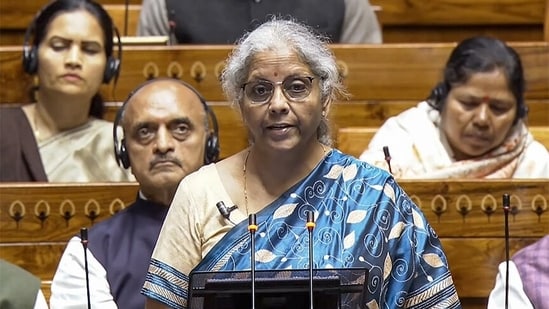Finance minister Nirmala Sitharaman’s focus on ‘Empowering Amrit Peedhi, the Yuva’, was categorical.

“Our prosperity depends on adequately equipping and empowering the youth. The National Education Policy 2020 is ushering in transformational reforms. PM Schools for Rising India (PM SHRI) are delivering quality teaching and nurturing holistic and well-rounded individualism,” she told the Parliament.
According to her, “the Skill India Mission has trained 1.4 crore youth, upskilled and reskilled 54 lakh youth, and established 3000 new ITIs. A large number of new institutions of higher learning, namely 7 IITs, 16 IIITs, 7 IIMs, 15 AIIMS and 390 universities have been set up.”
Her declarations underscored the All-India Survey on Higher Education (AISHE) 2020-2021 released by the central government in January 2023. The total enrollment in higher education increased to nearly 4.14 crore in 2020-21, up from 3.85 crore in 2019-20.
In terms of gender parity, women students enrolled have increased to 2.01 crore; by today’s estimate, in percentage terms there would be almost 49 per cent women enrolment.
The downside of higher education statistics is the number of scholarships and funds being provided for pursuing graduate or postgraduate degrees in colleges and universities, and for professional courses, such as medical and engineering students.
A few examples, from the Annual Report of Ministry of Education 2022-23:
· UGC implemented its “Basic Science Research Faculty Fellowship” with amount of Rs.6.01 crores released to 78 BSR Faculty Fellows during 2022;
· Dr. D. S. Kothari Post-Doctoral Fellowship in basic Sciences / Medical/Engineering and cutting edge technology, amount of ₹35 crores released to 612 fellows during 2022; this also includes salaries
· For Junior Research Fellowship (JRF) in Science, Humanities and Social Sciences an expenditure of Rs.1144.59 crore incurred 2022; for 9,400 awardees.
For an aspiring nation that wishes to build on its demographic dividend, it is indeed an uninspiring read of the Annual Report in its chapter titled ‘Regulatory and Advisory Bodies’.
Amidst applause, Sitharaman brought to public notice the PM Mudra Yojana which sanctioned 43 crore loans aggregating to “ ₹22.5 lakh crore for entrepreneurial aspirations of our youth. Besides that, Fund of Funds, Start Up India, and Start Up Credit Guarantee schemes are assisting our youth. They are also becoming ‘rozgardata’.”
Also read: Modi government woos ‘labhartis’ in Budget, continues with bucking up delivery systems with elections in sight
What students really want
When questioned about education, opportunities to study further, a graduate student asked: “Why are young adult students not eligible for no-interest finance, or let’s say, low-cost loans for further studies in India or in SAARC countries?”. This is the most-asked question by eager University students in metro-cities. They are eligible for student loans for two-wheelers and computers, at market rates, but for higher studies, students from urban or semi-urban areas are compelled to rely on family support.
“That means at least ₹50 lakhs for an educational course in Australia, the UK or the USA,” said a senior banking professional who secured an almost interest-free loan from her corporate organisation. She was unable to utilise the amount for her daughter whose mental health condition took a plunge for the worse; school performance pressure was one major factor.
For the finance minister to look into, and announce, what may be branded as, ‘Become the Vishwaguru’ student loan could be a game-changer, not necessarily because 2024 is the general election year. Most Union ministries – be it Minority Affairs, Social Justice and Empowerment, Labour and Employment, Tribal Affairs, Department of School Education and Literacy, and of course, Department of Higher Education – have innumerable Central Schemes and UGC-AICTE Schemes (besides state governments have their own schemes) offer scholarships and fellowships.
Also read: A 3-minute guide to understanding finance minister Nirmala Sitharaman’s interim Budget
Scholarship amounts are not enough
The roll-out of scholarship amounts is often termed inadequate: the scholarship scheme by Department of Higher Education, Ministry of Education to provide financial assistance to meritorious students from poor families has a maximum of 82,000 fresh scholarships; and the scholarship amount is ₹12,000 per annum at the graduation level, and ₹20,000 per annum at the post-graduation level.
Said Mohd Manzoor Alam, chairman of New Delhi-based Institute of Objective Studies (IOS), “Back in 1986, we realized the need to develop our scholarship programme aimed to promote learning and provide opportunities for talented and promising students. Through internal resources, we provided a total amount of ₹20 lakhs per annum for young scholars.”
IOS scholarship awardees could complete their education, find employment and the opportunity to give back to IOS in terms of service and credibility.
Also read: Nirmala Sitharaman’s interim budget puts spotlight on ‘four castes’ described by PM Modi
‘Become the Vishwaguru’ student loans would assist students and fellows in the form of monthly scholarships, study grants, travel grants, thesis preparation expenditure, payable over 15 or 20 years. There could be loans for 50 lakh students in phase 1, with ₹25 lakhs per loan being disbursed.
Sitharaman’s focus on delivering high growth in terms of Gross Domestic Product, i.e., ’Governance, Development and Performance’ would be met. “Our government has provided a transparent, accountable, people-centric and prompt trust-based administration with ‘citizen-first’ and ‘minimum government, maximum governance’ approach.”
The young student audience, it must be said, is awaiting this transformation.
The American Institute of Indian Studies website provides a likely solution, which had been developed in the United States and India over 60 years ago! “More than 6,000 scholars and creative artists have received AIIS support, with their work spanning the humanities, social sciences, social policy, and natural sciences,” it states.
That remains a go-to template.